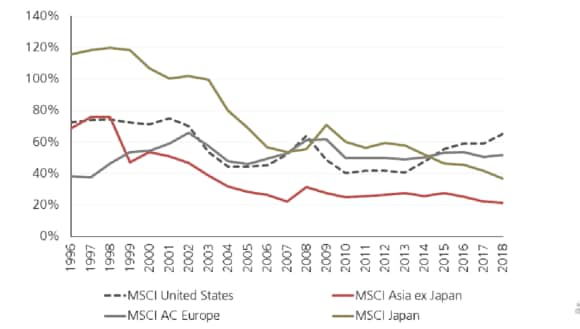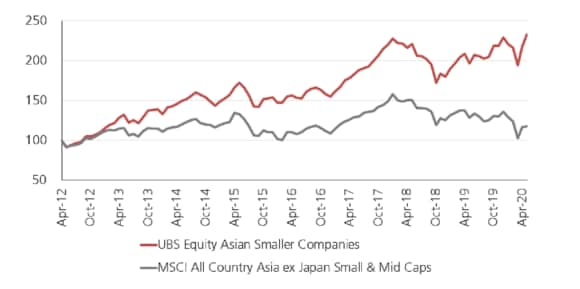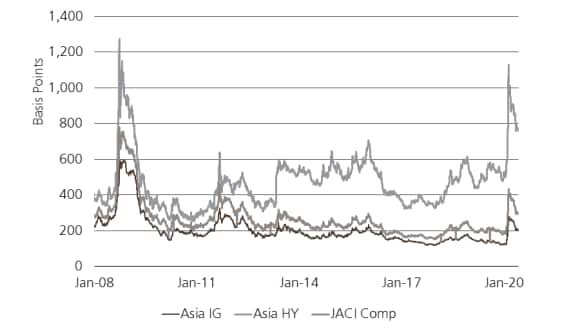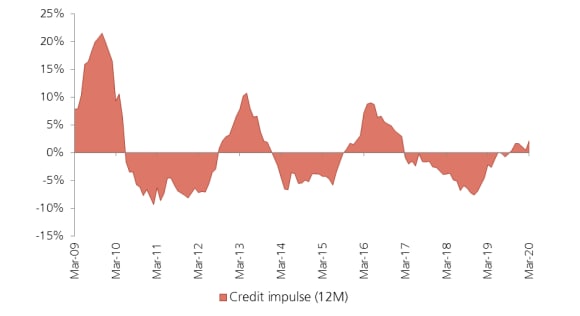Asia Market Outlook: 2H20 and 2021
Geoffrey Wong, Head of Emerging Markets and Asia Pacific Equities, and Hayden Briscoe, Head of Fixed Income, Asia Pacific, give their outlook for Asian economies, stocks and bonds for 2H20 and 2021 in an extensive media briefing.
Asia Outlook for 2H20 and 2021: Six Key Takeaways
Asia Outlook for 2H20 and 2021: Six Key Takeaways
- In 2021, the IMF expects 8.2% y-o-y GDP growth for China, 6.0% for India, and 2.4% for Japan;
- COVID-19 is having a severe short-term impact on Asia, but the long-term impact should be small;
- Asian stocks look cheap compared to both current levels in the US and Europe and historical valuations. We particularly see opportunities within the small-and mid-cap space;
- In Asian fixed income markets, credit spreads are at their widest since the Global Financial Crisis (GFC) in 2008/2009;
- The policy outlook in Asia is supportive and China has increased credit flows to the economy;
- Both Asia high yield and investment grade credits offer better yields and lower duration than the same asset classes in the US and Europe.
Asian Equities: The Outlook for 1H20 and 2021
Asian Equities: The Outlook for 1H20 and 2021
Geoffrey Wong, Head of Emerging Markets and Asia Pacific Equities
COVID-19 is having a severe short-term impact on Asia, but the long-term impact should be small.
Asian countries and companies went into this downturn in relatively sound shape: state fiscal balances are relatively healthy, Asian companies have comparatively defensive balance sheets, and Asia has seen no large build-up of excess capacity.
Net debt / Equity
Net debt / Equity

Activity levels in China and Asia are improving
Activity levels in China and Asia are improving
Though not yet back to pre-COVID-19 levels yet, we are seeing improvements.
Factories in places like China and Korea are now largely back to work.
Certain trends in Asia have accelerated
Certain trends in Asia have accelerated
Investible trends, including consolidation of weaker players within sectors, the shift from offline to online, investment in R&D and innovation, and supply chain shifts, have all sped up during the past six months.
Current valuations are cheap
Current valuations are cheap
Asian stocks look cheap compared to both current levels in the US and Europe and historical valuations. We particularly see opportunities within the small-and mid-cap space. Given that we are at the bottom of the cycle, we believe investors can find many value opportunities in Asia.
Long-term trends remain intact
Long-term trends remain intact
A range of investible trends remain intact in Asia, including an increasing share of discretionary spending, growing demand for premium consumer products, China’s rebalancing into services and consumption; rising spending on R&D and technology leading to innovations, under-penetration of credit, and Asia ex-China's expanding share in global manufacturing
Though the situation is challenging, underlying trends are creating winners and losers, and an active investment approach can open up opportunities and identify winners. We believe that the Asian small cap space is worth focusing on.
There will be winners and losers
There will be winners and losers
We believe that companies in sectors like consumer and healthcare that are exposed to the fundamental trends described above have the potential to be winners in the coming years. We also believe that an active approach to uncovering opportunities within these trends can benefit investors over the long term.
An active approach in Asian small caps can benefit investors
An active approach in Asian small caps can benefit investors

Asia Fixed Income 2H20 & 2021
Asia Fixed Income 2H20 & 2021
Hayden Briscoe, Head of Fixed Income, Asia Pacific
In Asian fixed income markets, credit spreads are at their widest since the Global Financial Crisis (GFC) in 2008/2009
In Asian fixed income markets, credit spreads are at their widest since the Global Financial Crisis (GFC) in 2008/2009
At current levels, credit spreads can deliver substantial yields into investors' portfolios. Investors should also bear in mind that periods of major market dislocations and drawdowns, like the GFC, are often followed by large returns for investors.
Asian USD Credit Market: Spreads
Asian USD Credit Market: Spreads

The policy outlook in Asia is supportive
The policy outlook in Asia is supportive
Asian central banks have more room than those in the US and Europe to deliver rate cuts over the next 12-18 months.
On the fiscal policy side, we believe Asian countries, and particularly China, are more effective, since they can put stimulus directly into their economies and business sectors.
China has increased credit flows to the economy
China has increased credit flows to the economy
That's positive for both China and Asia more generally, since China's economy is very influential in Asia. That said, China's approach is more restrained and much more targeted than episodes of stimulus in the past.
China Credit Impulse (Y0Y% Growth)
China Credit Impulse (Y0Y% Growth)

China's property sector offers opportunities
China's property sector offers opportunities
Urbanization and upgrading are key demand drivers. Property prices are recovering and developer profitability is improving.
We are positive on larger developers in the sector, most of whom are growing their market share as smaller players move out and have a diverse range of funding options.
Asia fixed income is a standout market globally
Asia fixed income is a standout market globally
Both Asia high yield and investment grade credits offer better yields and lower duration than the same asset classes in the US and Europe.
In US high yield, the energy sector is a major constituent, so if we take this sector out of the benchmark, the gap between yields in US and Asia high yield is very large indeed.
While sentiment has improved, Asian credit spreads are still at levels seen during the Global Financial Crisis. This presents attractive entry points for investors, especially for Asian high yield bonds
Make an inquiry
Fill in an inquiry form and leave your details – we’ll be back in touch.
Introducing our leadership team
Meet the members of the team responsible for UBS Asset Management’s strategic direction.
